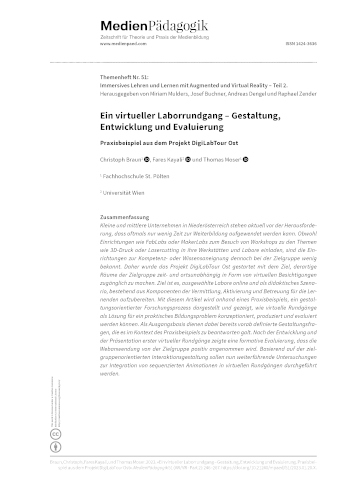Abstract
Small and medium-sized enterprises (sme’s) in Lower Austria are currently facing the challenge that often there is not enough time for further education available. Although facilities such as FabLabs or MakerLabs invite to attend on their workshops in the field of 3D printing or laser cutting in their workrooms and laboratories, the facilities are still little known at the target group for knowledge transfer. Therefore, the project DigiLabTour Ost was initiated targeting to make such spaces independently from time and location accessible to the target group using virtual tours. Selected laboratories should be online and prepared as a didactic scenario accessible. The article presents a practical example of a design-based research process and shows how virtual tours could be designed, produced, and evaluated to solve a practical problem in education. Starting from a set of predefined design questions which should be answered in the context of the practical example, the process of development and the first virtual tours followed. A formative evaluation showed that the web application is accepted by the target group. Based on the target group-oriented interaction design, further investigations on the integration of sequenced animations in virtual tours shall be conducted.
References
Andrews, Dorine, Blair Nonnecke, und Jennifer Preece. 2003. «Electronic Survey Methodology: A Case Study in Reaching Hard-to-Involve Internet Users». International Journal of Human-Computer Interaction 16 (2): 185–210. https://doi.org/10.1207/S15327590IJHC1602_04.
Blikstein, Paulo, Sylvia Libow Martinez, Heather Allen Pang, Kevin Jarrett, und FabLearn Fellows Initiative. 2019. Meaningful Making 2: Projects and Inspirations for Fab Labs & Makerspaces.
Bohne, Rene. 2013. «Machines for Personal Fabrication». In FabLab: Of Machines, Makers and Inventors, herausgegeben von Julia Walter-Herrmann und Corinne Büching, 163–72. Cultural and Media Studies. Bielefeld: transcript.
Bowman, Doug A., Larry F. Hodges, Don Allison, und Jean Wineman. 1999. «The Educational Value of an Information-Rich Virtual Environment». Presence: Teleoperators and Virtual Environments 8 (3): 317–31. https://doi.org/10.1162/105474699566251.
Braun, Christoph, Fares Kayali, und Thomas Moser. 2022. «Einsatz von virtuellen Rundgängen in der Distanz-Laborlehre: Praxisbeispiele aus dem Projekt Lab4home». Herausgegeben von Josef Buchner, Miriam Mulders, Andreas Dengel, und Raphael Zender. MedienPädagogik: Zeitschrift für Theorie und Praxis der Medienbildung 47 (AR/VR-Part 1): 196–219. https://doi.org/10.21240/mpaed/47/2022.04.10.X.
Dörner, Ralf, Christian Geiger, Leif Oppermann, und Volker Paelke. 2013. «Interaktionen in Virtuellen Welten». In Virtual und Augmented Reality (VR / AR), herausgegeben von Ralf Dörner, Wolfgang Broll, Paul Grimm, und Bernhard Jung, 157–93. eXamen.press. Berlin, Heidelberg: Springer. https://doi.org/10.1007/978-3-642-28903-3_6.
ecoplus. Niederösterreichs Wirtschaftsagentur GmbH. 2019. «Digital Innovation Hub Ost – Digitaler Wandel für KMUs in Ostösterreich». https://dih-ost.at/wp-content/uploads/pdf/ecoplus_DIHOST-Folder.pdf.
Euler, Dieter. 2011. «Wirkungs-vs. Gestaltungsforschung – eine feindliche Koexistenz?» Zeitschrift für Berufs- und Wirtschaftspädagogik 107 (4): 520–42.
Hellriegel, Jan, und Dino Čubela. 2018. «Das Potenzial von Virtual Reality für den schulischen Unterricht – Eine konstruktivistische Sicht». MedienPädagogik: Zeitschrift für Theorie und Praxis der Medienbildung 2018 (Occasional Papers): 58–80. https://doi.org/10.21240/mpaed/00/2018.12.11.X.
Klingauf, Anna, Johannes Funk, Angela Lüüs, und Ludger Schmidt. 2019. «Wirkung von interaktiven 3D-360°-Lernvideos in der praktischen Ausbildung von Handwerkern Vergleich von 3D-360°-Lernvideos mit konventionellen Lernvideos in Bezug auf den praktischen Lernerfolg auf einer Lehrbaustelle». In DELFI 2019, herausgegeben von Niels Pinkwart und Johannes Konert, 145–56. Bonn: Gesellschaft für Informatik e. V. (GI). https://doi.org/10.18420/delfi2019_298.
Krathwohl, David R., Benjamin Samuel Bloom, und Bertram B. Masia. 1978. Taxonomie von Lernzielen im affektiven Bereich. 2. Aufl. Beltz-Studienbuch 85. Weinheim Basel: Beltz.
Krosnick, Jon A., und Stanley Presser. 2010. «Question and Questionnaire Design». In Handbook of survey research, herausgegeben von Peter V. Marsden und James D. Wright, Second edition, 263–313. Bingley, UK: Emerald Publishing Limited. https://web.stanford.edu/dept/communication/faculty/krosnick/docs/2009/2009_handbook_krosnick.pdf.
Kuckartz, Udo. 2018. Qualitative Inhaltsanalyse: Methoden, Praxis, Computerunterstützung. 4. Auflage. Grundlagentexte Methoden. Weinheim Basel: Beltz Juventa.
Lazar, Jonathan. 2006. Web Usability: A User-Centered Design Approach. Boston: Pearson, Addison Wesley.
Lazar, Jonathan, Jinjuan Heidi Feng, und Harry Hochheiser. 2017. Research Methods in Human Computer Interaction. Second Edition. o. O.: Elsevier Science.
Lindgaard, Gitte, und Jarinee Chattratichart. 2007. «Usability Testing: What Have We Overlooked?» In Proceedings of the SIGCHI Conference on Human Factors in Computing Systems – CHI ’07, 1415–24. San Jose, California, USA: ACM Press. https://doi.org/10.1145/1240624.1240839.
McKenney, Susan E., und Thomas C. Reeves. 2019. Conducting educational design research. Second edition. London; New York: Routledge.
Nielsen, Jakob. 1994. «Enhancing the Explanatory Power of Usability Heuristics». In Proceedings of the SIGCHI Conference on Human Factors in Computing Systems Celebrating Interdependence – CHI ’94, 152–58. Boston, Massachusetts, United States: ACM Press. https://doi.org/10.1145/191666.191729.
Österreichische Forschungsförderungsgesellschaft mbH. 2020. «Programmdokument Digital Innovation Hubs». https://fdoc.ffg.at/s/vdb/public/node/content/IkqxU4ouRkSAIAsJkRKfnw/1.0?a=true.
Pfennig, Anja, und Jörg Maier-Rothe. 2019. «Lehrfilme einfach einfach machen – erfolgreiche Konzeptionierung von Peer-to-Peer Lehrfilmen». In DELFI 2019, herausgegeben von Niels Pinkwart, und Johannes Konert, 277–82. Bonn: Gesellschaft für Informatik e. V. (GI). https://dx.doi.org/10.18420/delfi2019_98.
Preece, Jenny, Yvonne Rogers, und Helen Sharp. 2015. Interaction Design: Beyond Human-Computer Interaction. Fourth edition. Chichester: Wiley.
Reinmann, Gabi. 2015. «Studientext Didaktisches Design». https://gabi-reinmann.de/wp-content/uploads/2018/07/Studientext_DD_Sept2015.pdf.
Rubin, Jeffrey, und Dana Chisnell. 2008. Handbook of usability testing: how to plan, design, and conduct effective tests. 2nd ed. Indianapolis, IN: Wiley Pub.
Sweller, John, Paul Ayres, und Slava Kalyuga. 2011. Cognitive Load Theory. Explorations in the Learning Sciences, Instructional Systems and Performance Technologies. New York, NY Heidelberg: Springer.
Zobel, Benedikt, Sebastian Werning, Lisa Berkemeier, und Oliver Thomas. 2018. «Augmented- und Virtual-Reality-Technologien zur Digitalisierung der Aus- und Weiterbildung – Überblick, Klassifikation und Vergleich». In Digitalisierung in der Aus- und Weiterbildung, herausgegeben von Oliver Thomas, Dirk Metzger, und Helmut Niegemann, 20–34. Berlin, Heidelberg: Springer. https://doi.org/10.1007/978-3-662-56551-3_2.
Zoerner, Dietmar, Paul Beschorner, Lars Michel, und Ulrike Lucke. 2021. «Minimal-invasive Messung lernrelevanter Parameter für den Einsatz im Game-based Learning». In DELFI 2021, herausgegeben von Andrea Kienle, Andreas Harrer, Joerg M. Haake, und Andreas Lingnau, 193–98. Bonn: Gesellschaft für Informatik e.V.

